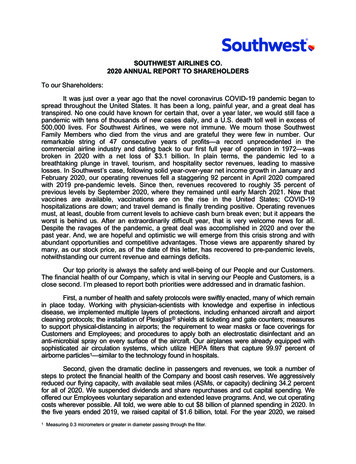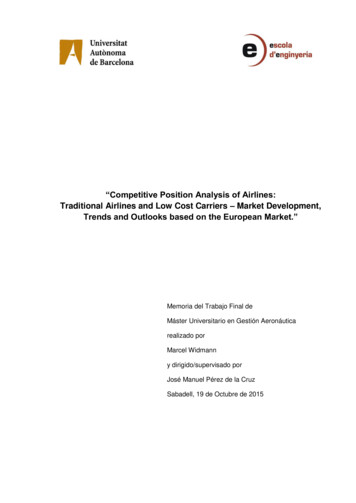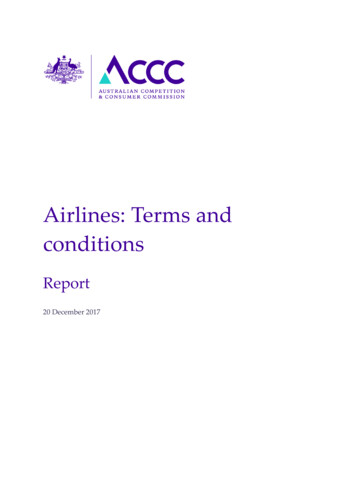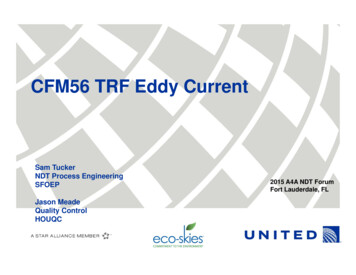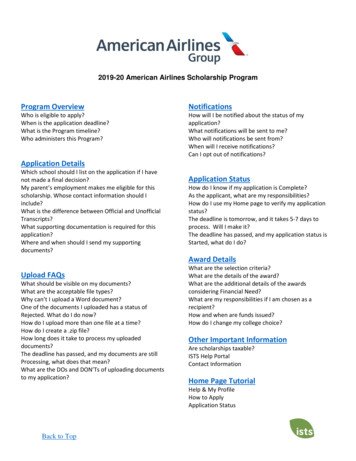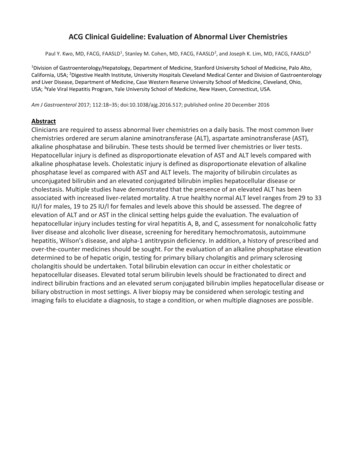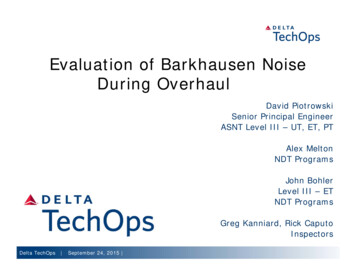
Transcription
Evaluation of Barkhausen NoiseDuring OverhaulDavid PiotrowskiSenior Principal EngineerASNT Level III – UT, ET, PTAlex MeltonNDT ProgramsJohn BohlerLevel III – ETNDT ProgramsGreg Kanniard, Rick CaputoInspectorsDelta TechOps September 24, 2015
Outline Barkhausen Noise Effect In-house Demoo Results Capability BNI Facilities Visit Data Collection studyo Remaining questions – False calls, sensitivity, learningcurve LG incident Pin heat damaged, confirmed withBN at Delta and Boeing; Phased ImplementationDelta TechOps September 24, 2015 2
Motivation Overhaul Preventing needless chrome stripo Avoids 7-10 day turn-time per part On-wing Preventing needless early gearremovalso B737NG NLG Axleo B777/767/757 Pivot bores Specified in numerous manualso B737NG Service Letter 2014o B777/767/757 Pivot Bore ADso Fleet NDT ManualsDelta TechOps September 24, 2015 3
THE BARKHAUSEN EFFECT A micromagnetic phenomenaobserved in ferromagnetic materials In the presence of a changingmagnetic field the net samplemagnetization changes Domains parallel to the applied fieldgrow at the expense of others As domains grow/shrink domainwalls move through the sample andare pinned by obstacles –dislocations, inclusions, precipitates,etc. These obstacles act as wall pinningsites, requiring more energy to pass When the requisite energy (H) isreached, the domain wall “snaps”past the pinning site This magnetization changes indiscontinuous “jumps”, akaBarkhausen “jumps”Delta TechOps September 24, 2015 4
DESCRIPTION OF BARKHAUSEN NOISE Stresstech Oy, based in Finland (U.S. representative is American StressTechnologies in Cheswick, PA). All the major landing gear manufacturers (Messier-Dowty, Goodrich/UTAS)as well as Boeing and Airbus use this inspection method, primarily formanufacturing quality control, but also during some overhaul operations. Barkhausen Noise inspection is an acoustically or inductively measuredsignal that comes from ferromagnetic materials when it is magnetized.–Domain movements produce “Barkhausen noise” BN measures the changes of the residual stress, hardness andmicrostructure, when magnetic field is applied. Developed for grinding burn detection, however, any manufacturingprocess that can change microstructure and/or stress is a good application.– Hard turning, heat treating, shot peening, grinding, carburizing treatments. Industry specifications: BAC 5653, SAE ARP4462, MIL specBN can detect burns through chrome platingDelta TechOps September 24, 2015 5
CAPABILITY DEMO – OverspeedGrinding Incident New machine installed, software error overspeed in certaincondition AST visit to demo and conduct study Two ‘suspect’ gear cylinders, 1 completed ‘overhauled’ gear,and Engineering specimens used BN inspection indications (through 0.008” thick chrome) Later, cylinder found ‘overtemp’ by Nital Etch, and crackingdiscovered with MPI in areas that BN inspection had identified as‘suspect’. Proves the ‘capability’ of Barkhausen Noise inspection to detectgrinding burns through chrome(0.008”).Successfully showed ‘capability’ to detect burns through chromeDelta TechOps September 24, 2015 6
CAPABILITY DEMO – OverspeedGrinding IncidentAxial and Circumferential ‘segment’ scans were acquiredDelta TechOps September 24, 2015 7
CAPABILITY DEMO140120100BNSignal80Plot 1Plot 12Plot 1360Plot 144020Areas whereBarkhausenNoise identifiedas suspectgrinding tial)270140120100Plot 1Plot 280Plot 3Plot 4BNSignal180Plot 560Plot 6Plot 7Plot 840200020406080100120Time/distance (nounits)BNI indications in both axial and circumferential scansDelta TechOps September 24, 2015 8140160180
CAPABILITY DEMONital etch indicationsmatch BNindicationsMPI indications ofcracking in affectedareaNital Etch and MPI confirmed the BNI indications as grinding damageDelta TechOps September 24, 2015 9
BNI FACILITIES VISIT Visited facility to examine BNI implementation Manufacturing automated BN process.– New part production applied to all axle ODs, with automated setup on lathe.– Not applied to ID surfaces, as those are plated to size and honed to finish. Only performed hand-scanning BN on overhauls (mostly military, C-17;Commercial AC use only if requested by customer).– Applied on all chrome plated surfaces following initial Stress Relief Bake.– A second test is accomplished if the part is ground following chrome plate. Process for investigating indications strip, nital etch. Frequency of indications 1-3% rate, reflecting in-service stresses, heatdamage, or ‘other’. False calls are approximately 50% of the ‘reject’ calls.–––––‘Undocumented’ Nickel-filled repairs.Inconsistent grit blast; Inconsistent shot peen.Inconsistent chrome thicknesses.Edge effect of chrome (finish grind poor run-out).Nicks and gouges on substrate.Many questions answered during visit – others createdDelta TechOps September 24, 2015 10
BNI FACILITIES VISIT At ‘overhaul’ facility, parts ‘wheeled’ over to the inspection area, similar toMPI (i.e., not on the lathe/grinder machine). In-house ‘process standard’ provided, follows BAC 5653/SRP 4462. Good records must be kept and parts mapped for reference; Can map onplastic overlay. Machinists, trained and certified as ‘Level IIs’ are trained to perform thistask. Level III involvement if questions on interpretation.– Approx 4 weeks of training (self-study & OJT, no classroom).– Approximately one year learning curve in both facilities to “understandwhat information the tool was providing”. Approx 30-45 minutes per inspection per axle. Probe life From three (3) to six (6) years. Annual PMET AST (BN vendor) visits both sites annually, and recertifiesthe equipment.Recurring theme: If handled correctly, BN is excellentDelta TechOps September 24, 2015 11
FEAR OF THE UNKNOWN ! BNI is very sensitive too sensitive? Will we be ableto process anything? False calls 50% of rejects? Sensitive to chrome thickness just like MPIlimitation? Learning curve? Ensure complete coverage – fixturing? Dedicatedlathe? Axial & Circumferential or just one? OD/ID? Reference Std, Procedure?o SAE ARP, BAC acceptable?o Boeing assistance Recommended a Data Collection Studyo AST Assistance in leasing equipmentLots of scary reasons to hesitateDelta TechOps September 24, 2015 12
BN Data Collection & Volume StudyProcedure:1. Ref Std made for 4340M using scrapped pin2. Internal Delta Technique Sheet made.Decided to ‘collect data’ for 9 months to answer questionsDelta TechOps September 24, 2015 13
BN Data Collection & Volume StudyReference standard made from scrapped pinDelta TechOps September 24, 2015 14
BN Data Collection & Volume Study 269 parts with BN data collected over 58 unique PNs: 154 were processed without Nital etch113 with Nital etch– 59 parts with BN indications and were stripped/nital etched– 54 parts had no BN indications, but were stripped/nital etchedanyway Shop order sequence (Visual/Dim, BN vs BN then Vis/Dim) For every instance of visual defects (chrome flaking, corrosion,wear), there were strong Barkhausen Noise signals. Thus, the59/113 parts with BN signals did have some type of visualdefect, which would require chrome strip and nital etch.Chrome wearprovides visual & BNIindicationData collection provided valuable info, learningDelta TechOps September 24, 2015 15
BN Data Collection & Volume Study 54/113 parts with no BN signals would have hadacceptable visual and dimensional inspections(Verified with Shop order).– It is these 54 parts which could be ‘saved’ by performingBN (i.e., by doing BN would allow for chrome to remain,thereby skipping plating removal, nital etch, replating,etc), which is an estimated 7-10 days of turn time perpart.Conclusion: By implementing the BarkhausenNoise inspection technique, many parts peryear would avoid 7-10 days of unnecessaryprocedures and turn time.Many concerns alleviated; Implementation recommendedDelta TechOps September 24, 2015 16
Failure Investigation767 Lower Torsion Link Pin Failure:1. Broken half inspected by DL – strong BN indication2. Boeing – confirmed BN indication3. “ showed evidence of base metal grinding burns under theChrome plate at the site of fracture origin.” Other Boeing examples of heat damage Delta has had 4 broken axles due to heat damage– Grinding during overhaul and– In-service damage (poor lubrication)History of issues, which could be solved with BNDelta TechOps September 24, 2015 17
Failure InvestigationNital etchMPIDepth of 4milsDelta TechOps September 24, 2015 18
Phased Implementation Implemented in Shop prior to overhaul 11 PN selected in initial round Follow the money – avoid needless strip (vshigh-risk parts)o Data mining to determine which parts Training program established: course, OJT Ramp-up slightly in 2016 Shifting to high-risk parts? On-wing applications being explored Post final-grind BNI being discussed Business cases by PNDelta TechOps September 24, 2015 19
Summary Capability demonstrated by in-house demo BNI Facility visit provided lots of info, but alsogenerated more questions, fears Data Collection study to alleviate fears: falsecalls, too sensitive, complete coverage Boeing NDT Manual, ref stds created Failure Investigation validated Phased Implementation during overhaulDelta TechOps September 24, 2015 20
Nital etch indications match BN indications MPI indications of cracking in affected area Nital Etch and MPI confirmed the BNI indications as grinding damage . Delta TechOps September 24, 2015 10 BNI FACILITIES VISIT Visited facility to examine BNI implementation Manufacturing automated BN process. – New part production applied to all axle ODs, with automated setup on lathe .
